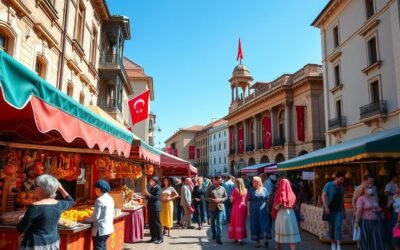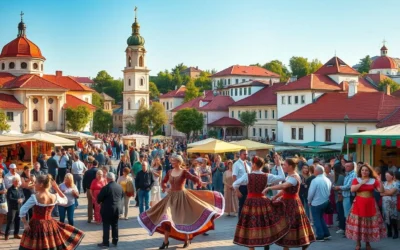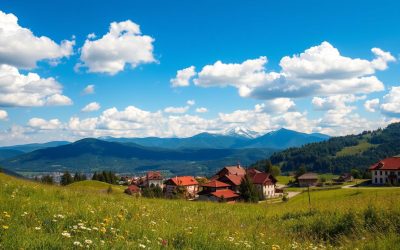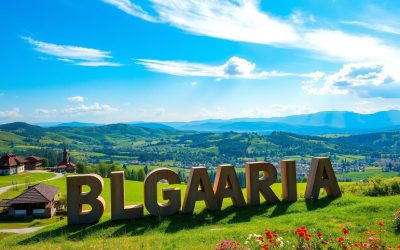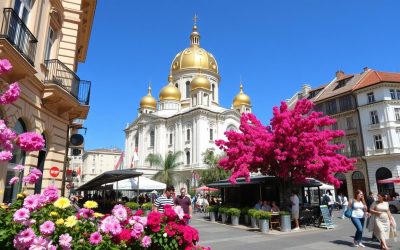✓ Tours & Activities ✓ Tours & Activities
Imagine strolling through dense, wild forests, relaxing on golden sandy beaches, or exploring emblematic cities steeped in history. You can experience all this and more in Bulgaria, a country that remains one of Europe’s most charming and affordable destinations.
Bulgaria is a hidden gem that offers something for every type of traveler. Whether you’re a beach lover, an adventure hunter, or a history enthusiast, this country has it all. With its unique blend of Balkan, Slavic, Ottoman, and European influences, Bulgaria provides an authentic and enriching experience for visitors.
In this article, we’ll explore the top attractions and experiences across Bulgaria, covering its diverse landscapes, historic cities, and cultural heritage, making it an ideal guide for first-time tourist in this captivating country.
Discovering Bulgaria’s Charm
If you’re looking for a unique travel experience, Bulgaria should be on your radar. As a country located in the heart of the Balkans, Bulgaria offers a blend of cultures, history, and natural beauty that is hard to find elsewhere.

Why Bulgaria Should Be Your Next Travel Destination
Bulgaria is a treasure trove of historical landmarks, cultural experiences, and breathtaking landscapes. The country’s unique position as a crossroads between East and West has resulted in a rich cultural heritage, with influences from various civilizations throughout history. Visitors can explore ancient ruins, medieval monasteries, and historic towns, or relax on the beautiful Black Sea beaches.
The affordability of Bulgaria compared to other European destinations makes it an attractive option for budget-conscious travelers. The welcoming nature of the Bulgarian people and their hospitality toward foreign visitors add to the country’s charm.
Best Time to Visit Bulgaria
The best time to visit Bulgaria largely depends on your planned activities. For beachgoers, summer (June to September) is the ideal time, with warm weather and long days. Ski enthusiasts will enjoy the winter months, with popular resorts like Bansko offering world-class skiing. For those interested in cultural exploration, spring and autumn are the best seasons, with mild temperatures and fewer crowds.
Understanding the local currency, the Bulgarian Lev, and being aware of visa requirements can help make your trip smoother. Bulgaria is generally a safe country for tourists, with low crime rates compared to other European capitals.
Explore Sofia: Bulgaria’s Captivating Capital
As you step into Sofia, Bulgaria’s captivating capital, you’ll uncover a city where ancient history and modern vibrancy blend seamlessly. With a history that stretches back thousands of years, Sofia is a city that has something for everyone.

Alexander Nevsky Cathedral: A Masterpiece of Orthodox Architecture
The Alexander Nevsky Cathedral is one of Sofia’s most iconic landmarks, boasting a striking gold-domed roof and exquisite Neo-Byzantine architecture. Built in the late 19th century to honor Russian soldiers who died during the Russo-Turkish War, this cathedral is not only a testament to Sofia’s rich history but also a masterpiece of Orthodox architecture.
The cathedral’s construction took over 20 years to complete and features an impressive interior adorned with stunning frescoes. As you explore the cathedral, you’ll be struck by its grandeur and the serene atmosphere that pervades this sacred space.
Boyana Church and Its Medieval Frescoes
Another significant historical site in Sofia is the Boyana Church, a UNESCO World Heritage Site renowned for its remarkably preserved medieval frescoes. Dating back to the 10th century, this Eastern Orthodox church is a treasure trove of historical and cultural significance.
The church’s frescoes, particularly those from the 13th century, are exceptionally well-preserved, offering a glimpse into the artistic and religious practices of the time.
Stroll Through Sofia’s City Garden and Vitosha Boulevard
After exploring Sofia’s historical landmarks, take a leisurely stroll through the City Garden, a beautiful green oasis in the heart of the city, and along Vitosha Boulevard, Sofia’s main commercial street lined with shops, cafes, and restaurants. The City Garden is home to the iconic Ivan Vazov National Theater and features picturesque fountains, making it a perfect spot to relax and enjoy the surroundings.
Vitosha Boulevard is ideal for people-watching, and you’ll find a variety of dining options to suit every taste. As you stroll along this bustling pedestrian street, you’ll experience the vibrant energy of Sofia.
Plovdiv: Europe’s Oldest Continuously Inhabited City

With its ancient ruins, cobblestone streets, and vibrant cultural scene, Plovdiv is a city that seamlessly blends history and modernity. As the second-largest city in Bulgaria, Plovdiv is a treasure trove of historical landmarks, cultural experiences, and exciting activities.
Wander Through the Charming Old Town
Plovdiv’s Old Town, also known as Staria Grad, is a charming area filled with colorful 19th-century Bulgarian Revival houses, narrow cobblestone streets, and picturesque alleys. As you wander through the Old Town, you’ll discover beautifully restored houses, quaint shops, and cozy cafes, offering a glimpse into the city’s rich history and cultural heritage.
Ancient Roman Theater and Stadium
Plovdiv is home to several impressive ancient Roman landmarks, including the Ancient Roman Theater and Stadium. The theater, built in the 2nd century AD, is a well-preserved amphitheater that still hosts performances today. The Roman Stadium, located in the city center, is another significant landmark that once held up to 30,000 spectators.
Kapana: The Trendy Creative District
Kapana, which translates to “the trap,” is Plovdiv’s trendy creative district, filled with street art, art galleries, and specialty shops. This vibrant neighborhood is known for its cozy cafes, chic bars, and restaurants, making it the perfect place to relax and enjoy the city’s lively atmosphere.
Plovdiv’s status as European Capital of Culture in 2019 has revitalized the city, making it an exciting destination for tourists and locals alike. With its rich history, cultural landmarks, and vibrant cultural scene, Plovdiv is a city that has something to offer for everyone.
Bulgaria’s Black Sea Coast: Sun, Sand, and History

Bulgaria’s 378 km Black Sea coastline is dotted with resorts, historical towns, and picturesque villages, making it an ideal vacation spot. You can enjoy a diverse range of experiences, from lively nightlife and water sports to historical exploration and relaxation on beautiful beaches.
Sunny Beach: Bulgaria’s Premier Resort Destination
Sunny Beach is Bulgaria’s largest and most popular resort, known for its wide golden beaches, water sports, and vibrant nightlife. Created in 1958, this tourist hotspot on the Black Sea has made a name for itself with its lively atmosphere and entertainment options. You can enjoy a variety of activities, including swimming, jet-skiing, and paddleboarding, or simply relax on the beach.
Burgas and Its Beautiful Sea Garden
Burgas is a charming city along the Black Sea coast that has inspired countless Bulgarian songs. The Sea Garden in Burgas is a sprawling park that runs along the coast, offering stunning views of the Black Sea on one side and vibrant flower beds, fountains, and sculptures on the other. You can take a leisurely stroll, visit the locals, and enjoy the attractions in the area.
Nessebar: Ancient History Meets Beach Vacation
Nessebar is a UNESCO-listed Old Town with a history spanning 3,000 years, featuring well-preserved medieval churches and wooden houses on a small peninsula connected to the mainland by a narrow isthmus. You can explore the ancient ruins, visit the historical sites, and enjoy the beautiful beaches in the area. Nessebar offers a perfect blend of beach vacation and cultural exploration.
In addition to these destinations, other notable places to visit along the Black Sea coast include Sozopol with its charming old town, Varna, Bulgaria’s third-largest city, and the upscale Golden Sands resort. The Black Sea coast offers excellent value compared to Mediterranean destinations while providing similar beach experiences. The best time to visit is from June to September when the weather is warm and the sea is perfect for swimming.
Rila Monastery: Bulgaria’s Spiritual Treasure

As you journey through Bulgaria, a visit to Rila Monastery is a must, given its historical and cultural significance. This sacred Orthodox monastery, founded in the 10th century by St. Ivan of Rila, is a testament to the country’s rich spiritual heritage.
The History and Architecture of Bulgaria’s Most Sacred Site
Rila Monastery is situated in the Rila Mountains at an elevation of 1,147 meters above sea level. The monastery’s impressive architecture features stone fortress walls, striped archways, and distinctive black and white patterns, making it a unique and breathtaking sight.
The historical significance of Rila Monastery cannot be overstated. It served as a center of Bulgarian spiritual and cultural life during the Ottoman rule, preserving the nation’s identity and cultural heritage.
Exploring the Monastery’s Stunning Frescoes
One of the most striking features of Rila Monastery is its incredibly detailed and colorful frescoes, which cover both the interior and exterior of the monastery. These frescoes depict biblical scenes and saints, adding to the monastery’s spiritual ambiance.
The main church, known as the Church of the Nativity, boasts a gold-plated iconostasis and houses the tomb of Bulgaria’s national saint. The monastery museum is also worth visiting, as it contains important historical artifacts, including the famous Rafail’s Cross.
For those planning to visit, Rila Monastery is approximately a 2-hour drive from Sofia. To avoid crowds, consider visiting early in the morning or later in the afternoon. This will not only enhance your experience but also allow you to appreciate the monastery’s serene environment.
Mountain Adventures in Bulgaria

With its three major mountain ranges, Bulgaria is a haven for nature lovers and thrill-seekers. The Rila, Pirin, and Balkan mountains offer a variety of outdoor activities throughout the year, making it an ideal destination for those who love nature and adventure.
Skiing in Bansko: Bulgaria’s Winter Paradise
Bansko is Bulgaria’s premier ski resort, located at the base of the UNESCO-listed Pirin National Park. It offers excellent slopes and facilities at prices much lower than Western European resorts. You can enjoy tree-lined runs, a supercharged atmosphere, and plenty of fun in the mountains.
Seven Rila Lakes: A Breathtaking Hiking Experience
The Seven Rila Lakes are a group of glacial lakes in the northwestern Rila Mountains, connected by hiking trails. You can take a cable car up the mountain and spend hours hiking, strolling, and admiring the views of the glacier lakes from different perspectives. This is one of Bulgaria’s most spectacular natural wonders.
Vitosha Mountain: Nature at Sofia’s Doorstep
Vitosha Mountain is visible from Sofia and offers hiking in summer and skiing in winter, just a short drive from the capital. It’s Sofia’s natural playground, providing opportunities for hiking, mountain biking, and skiing. You can enjoy the scenery and nature just a part of the city.
In conclusion, Bulgaria’s mountains offer a wide range of outdoor activities and breathtaking scenery, making it a great place for nature lovers and adventure seekers. Whether you’re looking for things to do in the mountains or just want to enjoy the natural beauty of the place, Bulgaria has something for everyone.
Unique Historical Sites Beyond the Tourist Trail
Explore the uncharted side of Bulgaria’s history by visiting some of its most intriguing and lesser-visited historical sites. Bulgaria is a country with a rich history, and while many flock to its well-known destinations, there are numerous hidden gems waiting to be discovered by those willing to venture off the beaten path.

Belogradchik Fortress
The Belogradchik Fortress is an ancient fortress located on the north slope of the Balkan Mountains. It is renowned for its spectacular rock formations, which were utilized to create an almost impenetrable defensive position. This historical site is a must-visit for anyone interested in history and scenery.
The Rock-Hewn Churches of Ivanovo
Near the city of Ruse, the Rock-Hewn Churches of Ivanovo are a group of monolithic churches, chapels, and monasteries carved into a solid rock face. Dating back to the 13th century, these churches have been declared a UNESCO World Heritage Site due to their remarkably preserved medieval frescoes, which showcase the evolution of Bulgarian medieval art.
Veliko Tarnovo
Veliko Tarnovo was the capital of the Second Bulgarian Empire and is dramatically situated on three hills above the Yantra River. The Tsarevets Fortress, the primary fortress and strongest bulwark from 1185 to 1393, is a significant historical site that offers breathtaking views of the surrounding landscape.
Other off-the-beaten-path historical sites worth visiting include Perperikon, an ancient rock city; the Madara Rider, a rock relief from the 8th century; and Koprivshtitsa, a preserved National Revival town. These attractions offer a glimpse into Bulgaria’s diverse history and culture, making them ideal for tourist looking for unique experiences.
Bulgarian Culinary Experiences

As you explore Bulgaria, you’ll find that the local cuisine is a warm and inviting reflection of the country’s hospitality. Bulgarian cuisine is a delicious blend of Balkan, Mediterranean, and Slavic influences, making it a must-try when visiting the country.
Must-Try Traditional Bulgarian Dishes
Bulgarian cuisine offers a variety of traditional dishes that are both flavorful and hearty. You should try banitsa, a cheese-filled pastry, and shopska salad, the national salad made with tomatoes, cucumbers, and sirene cheese. Other must-try dishes include kavarma, a slow-cooked meat stew, and kyufte, grilled meatballs. Don’t forget to experience Bulgaria’s yogurt culture and ayran, a yogurt drink that’s central to the country’s culinary identity.
Wine Tasting in Bulgaria’s Thriving Vineyards
Bulgaria has a long winemaking tradition dating back to Thracian times, over 3,000 years ago. The country produces excellent red varieties like Mavrud and Melnik, as well as white wines like Dimiat and Misket. Visit the Thracian Valley, Struma Valley, and Rose Valley to explore picturesque vineyards and tasting rooms. For an authentic dining atmosphere, head to a traditional Bulgarian mehana (tavern), where you can enjoy hearty food and folk music, feeling like you’re home with the locals.
Practical Travel Tips for Bulgaria
To make the most of your Bulgarian adventure, consider the following travel tips that cover transportation, currency, and communication.
Getting Around: Transportation Options
Bulgaria offers various transportation options, including buses, trains, and taxis. In major cities like Sofia and Plovdiv, public transportation is efficient. However, for exploring rural areas and mountains, renting a car is advisable due to the varying infrastructure across the country.
| Mode of Transport | Coverage | Convenience |
|---|---|---|
| Bus | Extensive, including rural areas | High |
| Train | Major cities and some rural areas | Moderate |
| Taxi | Major cities | High |
| Rental Car | Countrywide | High, for personal flexibility |
Currency and Budget Considerations
Bulgaria uses the Bulgarian Lev (BGN), although some places may accept Euros. It’s a good idea to exchange some currency to Levs upon arrival. Bulgaria is relatively affordable compared to Western Europe, with reasonable costs for accommodation, meals, and activities.
Language and Communication Tips
While younger Bulgarians often speak English, especially in tourist areas, learning basic Bulgarian phrases is appreciated. Be aware of the unique Bulgarian custom where nodding means “no” and shaking the head means “yes,” opposite to Western customs.

Conclusion: Why Bulgaria Deserves More Than One Visit
With its rich history, stunning natural beauty, and vibrant culture, Bulgaria is a traveler’s paradise that beckons you to return. You can experience diverse landscapes in a single trip, from the Black Sea beaches to the mountains.
Bulgaria’s compact size allows you to explore historic cities like Sofia and Plovdiv, visit the revered Rila Monastery, and enjoy the local cuisine. Each season offers a unique experience, whether it’s summer beach days or winter ski adventures.
Many travelers find themselves returning to explore areas they missed on their first visit. With its affordable prices and authentic experiences, Bulgaria is a destination that will keep you coming back.
The above is subject to change.
Check back often to TRAVEL.COM for the latest travel tips and deals.

